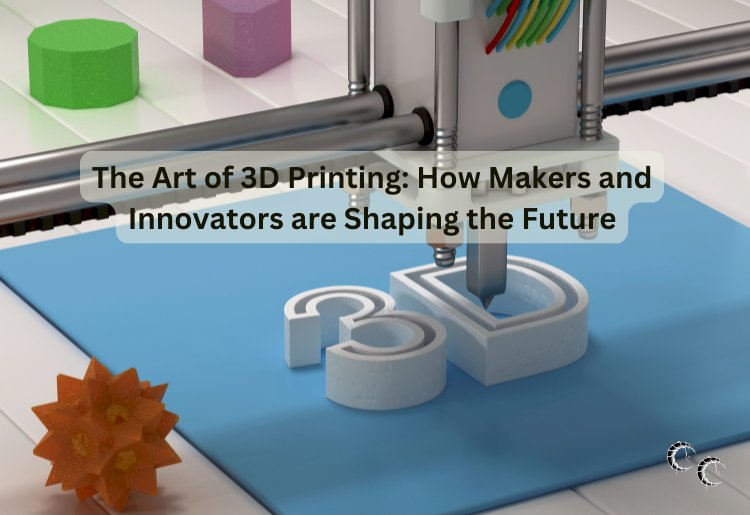The Art of 3D Printing: How Makers and Innovators are Shaping the Future

In the past few decades, technological advancements have revolutionized how we create, manufacture, and even think about design. One of the most transformative innovations in recent years is 3D printing—a process that is reshaping industries, democratizing creativity, and opening new doors to innovation. From hobbyists printing small objects in their garages to large corporations using 3D printing to create cutting-edge medical devices, the possibilities seem endless.
Once thought of as a niche technology, 3D printing has quickly become an essential tool across fields such as manufacturing, healthcare, architecture, and even space exploration. The blending of technology and creativity that 3D printing offers is allowing makers, innovators, and entrepreneurs to break down traditional barriers, disrupting industries and transforming the way we think about production and design.
In this article, we explore the art and science behind 3D printing and how it’s empowering makers and innovators to shape the future.
What is 3D Printing?
At its core, 3D printing—also known as additive manufacturing—is the process of creating a three-dimensional object from a digital model. Unlike traditional subtractive manufacturing, where material is removed from a solid block (e.g., cutting, drilling, or milling), 3D printing builds the object layer by layer, adding material until the final product takes shape.
The process typically begins with a 3D design created using CAD (Computer-Aided Design) software, or by scanning an existing object. This digital file is then sent to a 3D printer, where the printer reads the design and deposits material such as plastic, metal, resin, or even food ingredients in layers. The result is a physical object, made to exact specifications, from virtually any material that can be printed in layers.
3D printing allows for the creation of highly complex shapes and structures that would be difficult, if not impossible, to achieve with traditional manufacturing methods. It also eliminates many of the costs and waste associated with traditional production processes, making it an attractive solution for industries and individuals alike.
The Role of Makers in the 3D Printing Revolution
One of the most exciting aspects of 3D printing is the way it has empowered “makers”—hobbyists, artists, engineers, and DIY enthusiasts—to take control of the production process. The affordability of 3D printers and open-source software has democratized manufacturing, enabling anyone with a computer and a printer to design and create their own products.
-
Creativity Unbound Makers are using 3D printing to create an astonishing range of objects, from custom jewelry and home decor to intricate art pieces and functional prototypes. The ability to experiment with materials and shapes has unleashed new forms of creativity, allowing designers to produce one-of-a-kind items and push the boundaries of what’s possible.
For example, 3D-printed jewelry allows designers to craft intricate, customizable pieces that wouldn’t be feasible with traditional casting methods. Artists are experimenting with complex geometries, using 3D printing to create sculptures that challenge conventional forms. Whether it’s for artistic expression, personal use, or to fulfill specific functional needs, the creative possibilities are endless.
-
Prototyping and Innovation Makers and innovators are using 3D printing to rapidly prototype ideas, test concepts, and refine designs in ways that were once impossible. For entrepreneurs and startups, this has lowered the barrier to entry for product development. Instead of spending thousands of dollars and weeks or months on traditional prototyping, makers can now create a prototype on demand—sometimes within hours.
This agile approach accelerates innovation, making it easier to experiment with new designs and iterate on prototypes in real time. The iterative process is particularly valuable for inventors and small-scale manufacturers, as it allows them to refine a product before committing to expensive mass production.
-
The Maker Movement The broader maker movement has found a home in 3D printing. Communities of like-minded individuals, both online and in person, are collaborating and sharing designs, tips, and advice. Platforms like Thingiverse, MyMiniFactory, and YouMagine host repositories of user-generated 3D models, enabling anyone with a 3D printer to download and print pre-made designs. These platforms encourage collaboration, helping to build a global community of makers who are constantly innovating.
Hackathons, makerspaces, and online challenges also provide opportunities for creative individuals to push their skills and knowledge while contributing to the growing 3D printing ecosystem. The sharing of designs and ideas fosters an environment of innovation, where people from all over the world can experiment and create in ways that were previously unimaginable.
The Industrial and Commercial Applications of 3D Printing
While 3D printing has found a home in the world of makers and hobbyists, its true potential is being realized in the commercial and industrial sectors. The technology is revolutionizing manufacturing by offering faster production times, greater customization, and the ability to create complex parts and structures with ease.
-
Manufacturing and Supply Chain Disruption For industries like automotive, aerospace, and consumer electronics, 3D printing has enabled the creation of lightweight, durable, and highly customized components. For example, aerospace companies are using 3D printing to produce lightweight parts that reduce fuel consumption and enhance overall performance. With 3D printing, parts can be made on demand, eliminating the need for large inventories and reducing waste.
3D printing is also enabling more efficient and sustainable supply chains. By printing parts and products locally rather than relying on global supply chains, manufacturers can reduce costs and environmental impact. As the technology continues to advance, it’s likely that more industries will adopt additive manufacturing as a way to streamline their operations and improve efficiency.
-
Medical and Healthcare Innovations One of the most groundbreaking uses of 3D printing is in healthcare. The ability to print custom prosthetics, implants, and even organ models is transforming the medical field. 3D printing allows for highly personalized medical devices tailored to a patient’s specific anatomy, improving comfort and outcomes.
In addition to prosthetics, 3D printing is making strides in the production of medical equipment such as surgical tools and anatomical models for pre-surgical planning. Surgeons can use 3D-printed models of organs to practice complex surgeries, ensuring better precision during actual procedures.
Researchers are also working toward 3D printing human tissue, a process known as bioprinting, which has the potential to revolutionize organ transplantation and regenerative medicine. The possibilities for 3D printing in medicine are virtually limitless.
-
Architecture and Construction 3D printing is also making waves in the field of architecture and construction. With large-scale 3D printers, architects and builders can print entire buildings, reducing construction time, labor costs, and material waste. These 3D-printed homes and structures are not only cost-effective but also environmentally sustainable, as they can be built using recycled or sustainable materials.
In the future, 3D printing may be used to create entire cities, with customizable designs that are tailored to the needs of residents. The ability to print homes on demand in remote or disaster-stricken areas could also provide a solution to the global housing crisis.
The Future of 3D Printing
As 3D printing technology continues to evolve, its potential seems limitless. The materials used in 3D printing are becoming more advanced, with new options like metal, carbon fiber, and even food. The process is becoming faster and more efficient, with the cost of 3D printers continuing to drop, making the technology more accessible to individuals and businesses alike.
Looking forward, 3D printing will likely continue to shape the future of manufacturing, healthcare, education, and even space exploration. In fact, NASA has already experimented with 3D printing in space, using it to create tools and spare parts for astronauts aboard the International Space Station.
As new innovations and applications continue to emerge, 3D printing will undoubtedly play a crucial role in shaping the future of design and production. For makers, innovators, and entrepreneurs, the possibilities are endless—and the journey has only just begun.
Conclusion: Empowering the Future Through Creativity and Innovation
3D printing has transitioned from a novel concept to a vital tool, empowering makers and innovators to create, disrupt, and rethink what’s possible. Whether through creative expression, rapid prototyping, or solving global challenges, 3D printing has opened up a world of opportunities for anyone with an idea and the right technology.
As the technology continues to evolve, it promises to reshape industries, create new possibilities for personalization and customization, and even change the way we live, work, and play. From small-scale creative projects to life-changing innovations, 3D printing is shaping the future in ways that were once only imaginable in science fiction.





























